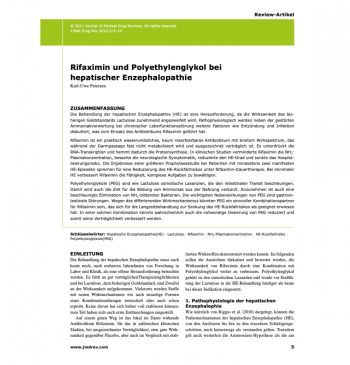Rifaximin and Polyethylene Glycol as treatment modalities in hepatic encephalopathy
J Med Drug Rev 2012;2;5-12
(Review in English and German language)
Treatment of hepatic encephalopathy (HE) is still a challenge as the efficacy of the former gold-standard lactulose has been questioned. In addition to disturbed ammonia processing due to chronic liver dysfunction, further pathophysiological mechanisms such as inflammation and infection are discussed. Rifaximin is an antibiotic practically insoluble in water, hardly absorbable and only very little metabolized during intestinal transit. It has a broad spectrum of antibacterial efficacy and shows an excellent tolerability. Rifaximin decreased in clinical studies the plasma concentration of NH3, improved neurological symptoms, reduced the grade of severity of HE, and diminished the risk of being hospitalized for HE. Results of a major study investigating long-term HE prophylaxis with rifaximin in patients with at least two manifest HE episodes suggest a reduction of the breakthrough risk. In patients with minimal HE, rifaximin improved the ability to execute complex tasks. Like lactulose, polyethylene glycols (PEG) are osmotic laxatives accelerating the intestinal transit. This shortens the time available for generation of ammonia from the passing food, possibly also hastens the elimination of NH3-forming bacteria. Most important side effects are gastrointestinal symptoms. Because of its different mechanism of action, PEG might be an attractive combination partner for rifaximin, which has been proven to be a suitable therapeutic option to maintain remission of HE. Such a combination therapy might probably result in a reduction of the PEG dose needed with the consequence of an improved PEG tolerability.
(Review in English and German language)
Treatment of hepatic encephalopathy (HE) is still a challenge as the efficacy of the former gold-standard lactulose has been questioned. In addition to disturbed ammonia processing due to chronic liver dysfunction, further pathophysiological mechanisms such as inflammation and infection are discussed. Rifaximin is an antibiotic practically insoluble in water, hardly absorbable and only very little metabolized during intestinal transit. It has a broad spectrum of antibacterial efficacy and shows an excellent tolerability. Rifaximin decreased in clinical studies the plasma concentration of NH3, improved neurological symptoms, reduced the grade of severity of HE, and diminished the risk of being hospitalized for HE. Results of a major study investigating long-term HE prophylaxis with rifaximin in patients with at least two manifest HE episodes suggest a reduction of the breakthrough risk. In patients with minimal HE, rifaximin improved the ability to execute complex tasks. Like lactulose, polyethylene glycols (PEG) are osmotic laxatives accelerating the intestinal transit. This shortens the time available for generation of ammonia from the passing food, possibly also hastens the elimination of NH3-forming bacteria. Most important side effects are gastrointestinal symptoms. Because of its different mechanism of action, PEG might be an attractive combination partner for rifaximin, which has been proven to be a suitable therapeutic option to maintain remission of HE. Such a combination therapy might probably result in a reduction of the PEG dose needed with the consequence of an improved PEG tolerability.




